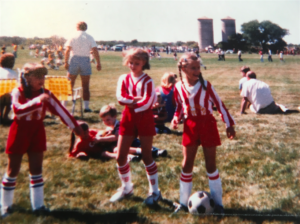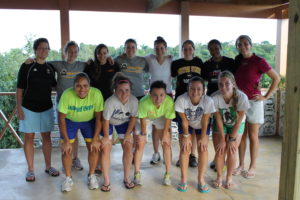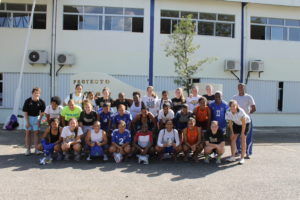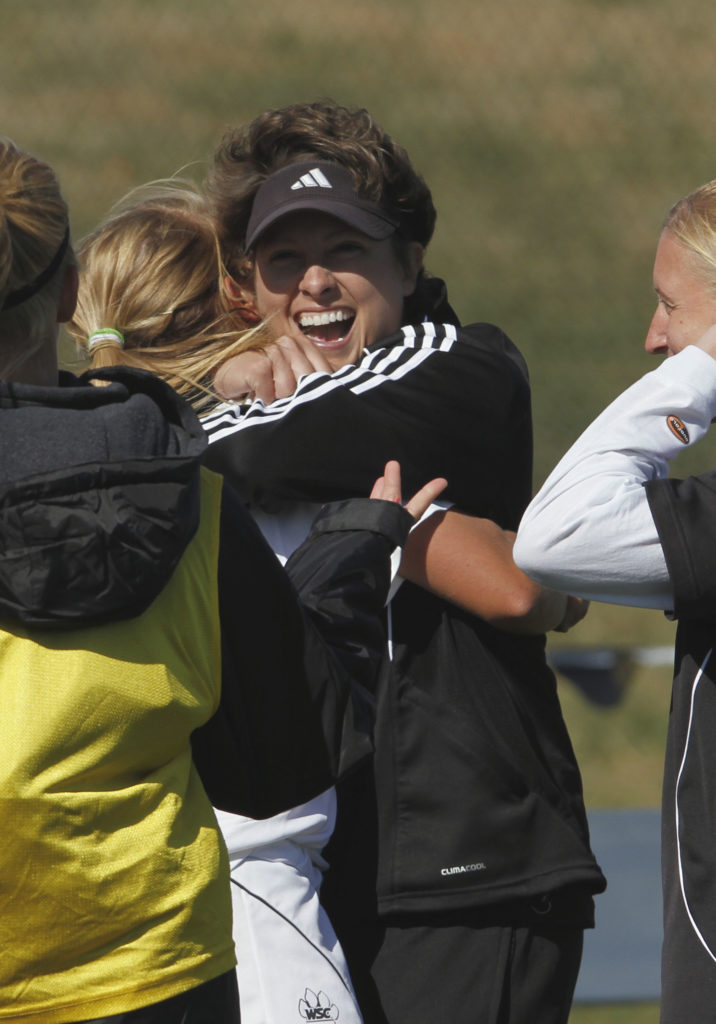Welcome to this incredible interview, #76, with Molly Grisham. She is a former NCAA coach and athlete. She is now a successful entrepreneur, specializing in leadership development. She has a gift for assisting coaches and players to be the leaders they were meant to be. She is the owner and founder of a leadership development company, A Person of Influence.
Molly is my first second time interview. I first interviewed her almost two years ago when she was coaching at the University of Illinois Springfield. I knew even then, she was a thoughtful and engaging leader.
Coaches (college, club and high school), if you have pain points in the culture of your team, don’t quit reading until the end of this interview! To my thousands of coaching colleagues in L.A. with me this week for the NSCAA convention, have a great week!
Whether you are a coach, player or business leader you will find Molly’s thoughts stimulating and encouraging. Read on to the end and you will find a link to a free online course from Molly: “How to Have a Hard Conversation with your Coach”.
You now own your own business, www.apersonofinfluence.com, where you work with coaches, teams and individuals to assist them to develop positive functional team cultures, service learning and leadership development. What are some of the common struggles college teams and players have?
I ultimately made the decision to leave college coaching so that I could share the process of developing better leaders, better people and healthier cultures with a wider audience. While each team is different, there does seem to be some common challenges that coaches and student-athletes are facing.
Most of the coaches I work with are quick to admit they have too much on their plate so the opportunity to bring in someone like me allows them to focus on the things they need to focus on and I can take the lead in terms of developing their people.
I also have coaches I work with who don’t have a background in developing leaders, but they realize their players need this. Bringing me in allows me to focus on my strengths and them to focus on their strengths. I think most coaches also struggle with budget decisions in terms of making a financial investment in leadership development. But what I know as a former college coach is this; we will spend our money on the things that matter and to me nothing matters more than developing our student-athletes as people.
In terms of student-athletes, I think today’s athletes are really struggling with communication. Most of them want to have hard conversations, want to be able to talk to their coach, and want to be able to express themselves but they just aren’t sure how to do that.
The good news is that it is a skill, and it can be taught. I am always grateful when a coach allows me to have access to their team so we can develop their players as people.
There is a common thread that many students-athletes don’t know how to define leadership. Many of them assume a leader is a captain, or a starter, or a senior. I love taking them through the process of defining leadership.
To me leadership is this; “a leader is a person of influence, who uses their influence for good by empowering, inspiring and serving others and as someone who is always willing to grow.” Ultimately leadership is a skill and leadership is a choice. If we are willing to make an investment in our student-athletes I think we can get them to make a choice to develop those skills and a choice to put those skills into action.
- Now on to Molly’s journey and we will circle back to more of her thoughts on empowering coaches and players.
When did you start playing soccer, and when did you know you that sports were going to be a major part of your life?

I started playing soccer when I was five years old and I knew right away that I love the game. Growing up I also enjoyed playing basketball but soccer was always my sport of emphasis. I think I loved the game because it allowed me to be a part of something bigger than myself. The feeling of being a part of a team was always something special to me.
Where did you play high school and club soccer?
I played high school soccer at Glenwood High School in Chatham IL and I played club soccer in Central Illinois.
What were the differences between your high school and club experience? What were the benefits of each?
My high school and club experiences were very different, but they both provided great learning opportunities for me.
My high school didn’t get girls soccer until my sophomore year so that was an opportunity to be a part of something new and to play with players I hadn’t played with before.
Club soccer was a much higher level and I was playing with girls from all over Central Illinois. Each of those girls were the best on their team so I was challenged to bring my best every single day. It’s different today, because so many players feel like they have to choose between high school or club and I think that is unfortunate because both experiences can bring something positive into your life.
What was your own recruiting journey like?
My recruiting journey was very different from what it is today. I went to college in the early 90s and there were very few schools with women’s college soccer. We didn’t have the technology available today which plays such a key role in recruiting. I think today players often feel overwhelmed by the number of schools that might be interested in them. I didn’t experience that because so few programs had women soccer.
As a high school student I committed to Quincy University. I knew I wanted a school that was within a 5-6 hour drive of home. I knew I wanted to be challenged as a player. At that time Quincy was ranked as a Top 10 Division 2 program and I knew that would push me as a player.
I had played club soccer with several players on their roster and a couple of their incoming recruits were on my club team and that was a big selling point for me. I knew I would spend a lot of time with my teammates so making sure I would be surrounded by good people was important to me. On my visit, it felt like home.
What I didn’t know at the time was what I wanted study in college. I eventually transferred to Belmont University because Quincy didn’t have what I wanted to pursue academically. I have no regrets about attending either school. Both schools were wonderful for my development as a player and as a person. Several of my QU teammates are still some of my closest friends.
The process of transferring impacted the advice I gave recruits as a coach. I always advised recruits who weren’t sure what they wanted to study to select a school with a wide variety of majors. Odds are you are going to love your school and love your teammates which makes transferring is a difficult decision. If you pick a school with a variety of academic options you may be able to avoid the path I needed to take.
What advice do you have for high school athletes who dream of playing in college but are confused by the recruiting process?
Like any big decision you make in life you have to take ownership of the process. I think a lot of recruits and their parents think that recruiting is some sort of game you have to learn how to play, but to me it’s all about relationships. As a recruit, you need to take advantage of the recruiting process to develop honest relationships with the person who might be your future coach. You can do that by doing your research about the school, the program, and the coach and being prepared with questions when you visit.
Make sure you as the recruit are the one making the phone calls and returning emails. If the coach feels like they have a good relationship with you then they are more likely to envision coaching you in the near future. Just like you want the coach to be honest with you, you need to be honest with them.
You coached at Wayne State and the University of Illinois. I know leadership is important to you. How did you develop leaders on your teams?
On every team I’ve ever coached leadership development has been a point of emphasis. It is clear to me that teams with great leaders are more successful and enjoy the experience more. I certainly worked one-on-one with our team captains but I also worked hard to encourage all of our players to see themselves as leaders.
Some of the things we did in the past were to read books together and talk about our insights or observations about those books. Those times were always helpful for us to learn from each other. I also used a lot of activity-based learning exercises to help our players develop better communication skills, problem-solving skills, and conflict resolution skills.
times were always helpful for us to learn from each other. I also used a lot of activity-based learning exercises to help our players develop better communication skills, problem-solving skills, and conflict resolution skills.
I tried to incorporate those leadership moments into our training environment. If we want players to lead on the field then we have to find ways to talk about that in training and incorporate it into our training environment.
I remember one off-season when I was meeting with our new Captains. They were a sophomore and a junior. We were meeting weekly to help develop them as leaders.
I thought the last week had been uneventful. There were no problems and no drama. As we began the meeting they told me a list of everything they had dealt with that week and I was shocked. I didn’t know about anything of this. They told me two players weren’t getting along and they each sat down with one of them and then had a meeting with both of them. They coordinated a study session for the freshmen who were all stressed about a Biology midterm and they spent extra time with a player who had just gone through a tough break up.
I was so happy because they were putting their leadership skills to great use and they knew they were empowered to take action on our team. The time and energy I put into investing in them was well worth it!
Often college coaches feel like they are putting out relational fires within their team. What are some things coaches and players can do to be intentional to prevent those fires and thrive as a team?
If you are just putting out fires that tells me your student-athletes haven’t developed the skills to create a different culture. When we teach student-athletes specific skills they create a new culture.
As coaches we need to integrate leadership into our program. A simple way to do this is to identify and praise the moments when our players show leadership skills. Leadership is all about developing skills and we as coaches need to drive that process.
Leaders Do the Dirty Work
One of the things I believe about leadership is the idea that great leaders do the dirty work. Great leaders are willing to do what no one else wants to do. They will do the thankless jobs others walk away from. In the sport of soccer, one of the ways to do the dirty work is to sacrifice your body to prevent giving up a corner kick. When I see a player sprint to a ball that everyone else assumes is going out, slide across turf to kick the ball out for a throw-in and stand up with a 3 layers of skin now missing from the back of her legs you better believe I am going to mark that as a clear leadership moment.
It doesn’t take more than 30 seconds out of training for me to stop and praise that player for leading by doing the dirty work. What we talk about and praise will be repeated and we need to be more international in terms of talking about leadership.
Another way we can help our players to lead and take ownership is to have a clear set of team values so players understand their boundaries and then they can help to keep the team within those boundaries.
Embrace Core Values
In my last two programs we used what we called, “The Starting XI”, which encompassed our 11 core values. We talked about how we could only play with 11 players on the field but if our entire roster embraced The Starting XI it would make us a more powerful team.
 Each year in preseason we asked our players to share which one value really spoke to them. In this process we learned so much about what mattered to our players. This also helped in conflict on our team. For example, we had one player who really embraced the following value; “Honor the truth. Speak honestly and listen with an open mind, be slow to judge and quick to forgive always seeking to find the best in each other. When necessary agree to disagree out of mutual respect. There is no greater gift that a second chance, give it often.”
Each year in preseason we asked our players to share which one value really spoke to them. In this process we learned so much about what mattered to our players. This also helped in conflict on our team. For example, we had one player who really embraced the following value; “Honor the truth. Speak honestly and listen with an open mind, be slow to judge and quick to forgive always seeking to find the best in each other. When necessary agree to disagree out of mutual respect. There is no greater gift that a second chance, give it often.”
This made sense to all of us since she was the most honest player I’ve ever coached. But there were times when her teammates were dishonest and that caused tension on the team. Instead of seeing her as someone who created tension they began to understand that honesty was a part of her core values. Being honest really mattered to her and instead of wanting her to “get over it” they began to embrace that part of her. When we have clear values we are able to give our team ownership in maintaining those values.
We have to get coaches to make an investment in leadership and culture, and this can’t just be something that we do in the off-season. The exciting part is this is something coaches can implement today. They can bring in a consultant, they can have their team read books together, they can use activities we post in The Circle of Influence, they can share blogs we post as a way to talk about leadership, they can utilize our team curriculum called Leadership Discovery and most certainly they can point out the great leadership moments they are already seeing within their team. If coaches aren’t sure where to start or what to do then please ask for help, that’s what I am here for.
You are passionate about leaders being people of influence. What is one tip you could give the athlete reading this on how they can begin to be a person of influence?
Great leaders love their people. If you want to lead, you need tangible ways you express your care and concern for those you want to lead. Think about the people you are leading. What ways do you show them you care? Great leaders can make a long list of ways they show that they care.
Hard conversations are a part of life, but they are really a part of sport. In my experience coaches and players see these interactions as negative. How can they be positive?
This is such a struggle but also a great opportunity. If we can learn how to have hard conversations, we can move to a new place with a new outcome.
What is the Real Issue?
One of the first things we need to do as coaches is to make sure we really understand the issue – this is what I often call the issue behind the issue. One of the tools I liked using was what we called our Stress Level worksheet. We gave this to our players in the middle of each semester and they ranked their stress level in about 15 different categories.
I remember a player who was our starting Keeper the previous season but this season her role had changed, she was now our backup Keeper. I was beginning to notice tension between with the coaches and this player. I started to think that a hard conversation was coming about her attitude because I assumed she was mad about not being the starting Keeper. Thankfully I read her Stress Level worksheet before I spoke to her. On her worksheet she marked “My Relationship with My Coaches” as her highest stressor, a 10/10 and I was shocked. She made a note next to this category that said something like this, “I know I am the backup Keeper now, and that is where I deserve to be, Annie is a much better Keeper than me. But when I was the starter I got to spend more time with the coaches and I miss that and I am not sure how to handle that.” I thought she was mad, but really she was missing her coaches and trying to figure out how to navigate that.
This was an easy fix for me! I brought her in and we talked about it, I told her I was sorry this was her biggest stressor and we were going to work together to reduce her stress. As a staff we began to look for other ways to include her and spend time with her and that made all the difference for her and for our team. Had we not known the real issue we would have solved the wrong problem and we probably would have created more problems in the process.
Hard Conversations
As coaches we also have to demonstrate hard conversations for our players. I remember one season when we simply couldn’t defend a corner kick. If the other team got a corner kick they could go ahead and add a goal for the opponent on the scoreboard. I had watched film for hours and I had a plan. We headed out to practice and knew we had 2 hours to fix this problem. We made it clear to our players we had to fix this now and they knew we weren’t happy with our performance defending corner kicks. It was an intense and very focused practice.
Our players were going through the changes in the ways I wanted them to defend corners when our Keeper Coach said she has a suggestion. I made the decision to stop practice so the team could hear our conversation. We made sure to talk loudly enough so they could hear us and I was very aware they were paying close attention to our interaction. You could feel the players thinking, “this could get ugly.” But we didn’t let that happen. We consciously demonstrated how to have a hard conversation in front of our team. We both talked, listened, asked questions and tried what the other person was suggesting with our team watching in real time. For the record, my Keeper Coach was right. We went with her suggestion and it paid off in more ways than one. We stopped giving up goals on every corner kick AND our players learned you can survive hard conversations.
Free Online Course: How to Have a Hard Conversation with your Coach
As a result of this struggle, I designed a free online course called How to Have a Hard Conversation with your Coach. This course walks a student-athlete through the process of figuring out how to talk to their coach. We’ve got some schools that are requiring their student-athletes, parents, and coaches to go through the course. It’s free and takes about 45 minutes. It can be found here.
If you want help developing your people please let me know!
Molly Grisham
- Bryan: I have an affiliate relationship with Molly. If you are interested in her services it helps fund The Recruiting Code if you go through any of the links from this website to A Person of Influence. The price is the same to you.
LIKE WHAT YOU READ?
Please take a moment to share it on social media to benefit other coaches or prospective college athletes, by clicking on the “sharing is caring” buttons below.
Thanks,
Bryan


